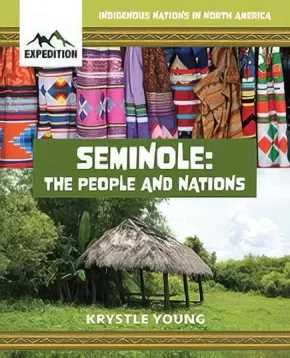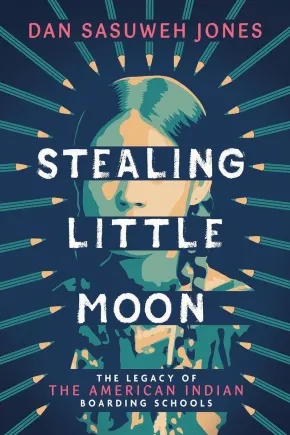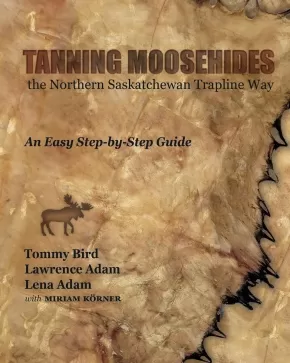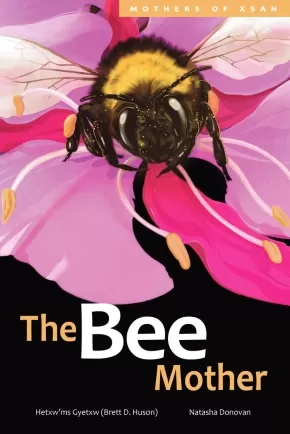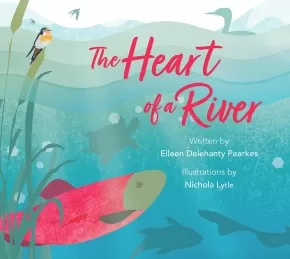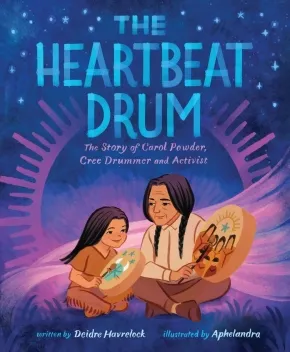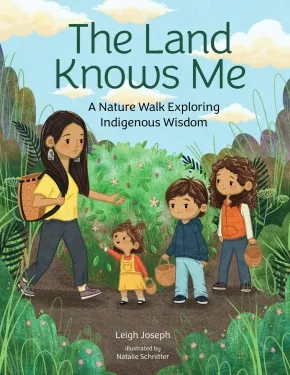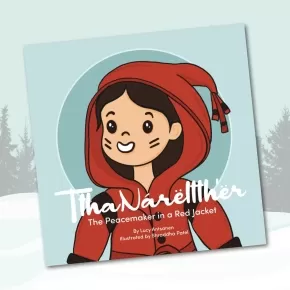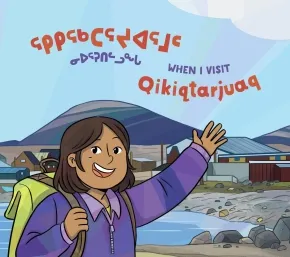
Indigenous Peoples
76
-
90
of
409 Results;
Sort By
Go To
of 28
Seminole: The People and Nations
$16.95
Format:
Paperback
Text Content Territories:
Indigenous American; Native American; Seminole;
ISBN / Barcode: 9781774565148
Synopsis:
Synopsis:
Orginating from Florida, the Seminole nation has a deep history in North America. Discover more about the Seminole nation, their traditions and story.
Educator & Series Information
This book is part of the Indigenous Nations in North America series.
Additional Information
32 Pages | Paperback
Stealing Little Moon: The Legacy of the American Indian Boarding Schools
$26.99
Format:
Hardcover
Text Content Territories:
Indigenous American; Native American; Ponca; Ponca Tribe of Indians of Oklahoma ;
ISBN / Barcode: 9781338889475
Synopsis:
Synopsis:
"Stealing Little Moon is both a moving family saga and an expertly told true story that all Americans should know." —Steve Sheinkin, New York Times bestselling author of Bomb and Undefeated
Little Moon There Are No Stars Tonight was four years old when armed federal agents showed up at her home and took her from her family. Under the authority of the government, she was sent away to a boarding school specifically created to strip her of her Ponca culture and teach her the ways of white society. Little Moon was one of thousands of Indigenous children forced to attend these schools across America and give up everything they'd ever known: family, friends, toys, clothing, food, customs, even their language. She would be the first of four generations of her family who would go to the Chilocco Indian Agricultural School.
Dan SaSuWeh Jones chronicles his family's time at Chilocco--starting with his grandmother Little Moon's arrival when the school first opened and ending with him working on the maintenance crew when the school shut down nearly one hundred years later. Together with the voices of students from other schools, both those who died and those who survived, Dan brings to light the lasting legacy of the boarding school era.
Part American history, part family history, Stealing Little Moon is a powerful look at the miseducation and the mistreatment of Indigenous kids, while celebrating their strength, resiliency, and courage--and the ultimate failure of the United States government to erase them.
Educator Information
Recommended for ages 9 to 12.
Additional Information
304 pages | 5.50" x 8.25" | Hardcover
Tanning Moosehides: The Northern Saskatchewan Trapline Way
$49.95
Format:
Coil Bound
Text Content Territories:
Indigenous Canadian; First Nations; Dene; Denesuline (Chipewyan); Fond du Lac Denes??iné First Nation; Cree (Nehiyawak); Woodland Cree; Rocky Cree; Peter Ballantyne Cree Nation;
ISBN / Barcode: 97817786903
Synopsis:
Synopsis:
Denesųłiné Elders Lawrence and Lena Adam have been tanning hides and sharing their knowledge with others for more than four decades. Woodland Cree knowledge carrier Tommy Bird helped his family tan hides on the trapline as a young boy. Together they share their lifetime of experience to guide a new generation of hide tanners to keep the tradition alive. The trouble-shooting tips and hands-on advice in this book will help you to make your own bone tools and turn raw moosehides into smoke-tanned hides soft enough to sew into mitts or moccasins. Combining traditional knowledge with easy-to-follow instructions and detailed colour photos, Tanning Moosehides the Northern Saskatchewan Trapline Way is a practical guide you will refer to again and again.
Educator Information
The publisher recommends this resource for ages 10+
Recommended in the Indigenous Books for Schools catalogue as a valuable resource for Art, Science, and Social Studies in grades 5 to 12.
Themes: Animals, Arts and Culture, Cultural Teachings, Fashion, Traditional Knowledge.
Additional Information
64 pages | 8.50" x 11.00" | Spiral Bound
Teachings of the Drum
$12.95
Format:
Hardcover
Text Content Territories:
Indigenous Canadian; First Nations; Nuu-chah-nulth (Nootka);
ISBN / Barcode: 9781778540387
Synopsis:
Synopsis:
The drum is a special symbol in many Indigenous cultures. In this rhyming picture book, young Ren is given a handmade drum by his mother that help to teach him many things about himself and his culture.
An adaptation of the best-selling book, Drum from the Heart, by Indigenous author Ren Louie for ages 4-6.
Educator Information
Recommended for ages 4 to 6.
This book is an adaptation of Drum from the Heart for ages 4 to 6.
This book is available in French: Les enseignements du tambour
Additional Information
24 pages | 8.50" x 7.50" | Hardcover
The Bee Mother
$24.95
Artists:
Format:
Hardcover
Text Content Territories:
Indigenous Canadian; First Nations; Gitxsan (Gitksan);
ISBN / Barcode: 9781774920800
Synopsis:
Synopsis:
Discover the important role of bumblebees, honeybees, and wasps as pollinators in this colourful picture book for young scientists.
Learn about the life cycles of different kinds of bees in this enlightening picture book.
As flowers and trees begin to bud and bloom, Nox Ap, the bee mother, emerges from her winter sleep. To the Gitxsan, she is nature’s gardener. Without her hard work as a pollinator, we could not enjoy the fruits of strawberries and huckleberries. Follow her life from the first thaw of spring to the end of autumn.
In the seventh book of Hetxw'ms Gyetxw (Brett D. Huson)’s Mothers of Xsan series, readers will discover the important role of the bumblebee, the honeybee, and the yellow jacket wasp in the Xsan ecosystem.
Reviews
“Described with delicious adjectives (“pillowy moss floor”) that enrich the story...lushly colored and detailed; the fur on the bumblebee looks ready to be brushed. This great blend of nonfiction with narrative and amazing illustrations will engage readers in the life of bees and their significance to the Gitxsan Nation. A solid general purchase.” — School Library Journal
Educator & Series Information
Recommended for ages 9 to 12.
This book is part of the Mother of Xsan series, which uses striking illustration and lyrical language to bring the poetry of the Xsan ecosystem to life. It is the seventh book in the series.
Reading Level: Fountas & Pinnell T
Lexile® Framework for Reading: 1140L
Recommended in the Indigenous Books for Schools catalogue as a valuable resource for English Language Arts and Science in grades 2 to 6.
Themes: Animals, Land, Language, Sustainability, Life Cycles, Biodiversity, Interdependence, Seasons
Additional Information
32 pages | 6.50" x 10.00" | Hardcover
The Cherokee Syllabary: An Illustrated Key to the Cherokee Language
$21.95
Artists:
Format:
Hardcover
Text Content Territories:
Indigenous American; Native American; Cherokee;
ISBN / Barcode: 9781570674228
Synopsis:
Synopsis:
The Cherokee Syllabary: An Illustrated Key to the Cherokee Language reintroduces adults as well as children to their language once again. The introduction and pronunciation key aid in understanding the beautifully illustrated syllabary characters. Accompanying each illustration is a Cherokee word that contains the Cherokee syllabary character, the Cherokee sounds of each syllabary character in the word, the word in English and a row of syllabary characters with sound of each below. Young children will be enchanted by the delightful illustrations. The concept for the illustrations was influenced by medieval illuminated manuscripts. The book is a valuable educational resource for schools and libraries that adds multicultural diversity to their classrooms and collections.
Educator Information
Recommended for ages 6 to 8, but anyone learning the Cherokee language could find this useful.
Includes an Understanding the Text page, nothing that the Cherokee alphabet isn't an alphabet but a syllabary (each Cherokee character represents a complete syllable) and explaining more about the information in the book.
Additional Information
40 pages | 8.50" x 8.50" | Hardcover
The Heart of a River
$18.00
Artists:
Format:
Paperback
Text Content Territories:
Indigenous American; Native American; Salish; Interior Salish; Sinixt; Indigenous Canadian; First Nations; Salish; Interior Salish; Sinixt;
ISBN / Barcode: 9781771607001
Synopsis:
Synopsis:
This is a book for anyone, of any age, who cares about rivers.
This story of the Columbia River is unique. Told from the river’s perspective, it is an immersive, empathetic portrait of a once-wild river and of the Sinixt, a First People who lived on the mainstem of this great western river for thousands of years and continue to do so even though Canada declared them “extinct” in 1956.
The book’s re-release comes at a critical time for natural systems and for reconciliation with Indigenous Peoples across North America. The Colville Confederated Tribes, representing over 3,000 Sinixt People, recently won a precedent-setting case in the Supreme Court of Canada affirming that Aboriginal Rights do not stop at the border. The important story of the Sinixt weaves together with the ongoing ecological impact of hydropower development on the Columbia and its tributaries.
Central to the story is the joyous spirit of salmon, once a free swimmer in the Columbia’s currents north of the border but now blocked from ancestral spawning grounds by Grand Coulee and other dams. Restoring migratory fish indigenous to the Upper Columbia will require transboundary cooperation. With Indigenous Nations on both sides of the US–Canada border now leading the way, many are hopeful that the fish will return.
Lavishly illustrated by Nelson, BC, designer Nichola Lytle, this portrait of a globally significant river will inspire anyone who reads it to care about the future of the salmon, a fish that unites all of us in its quest for freedom and possibility.
Educator Information
Recommended for ages 4 to 8.
Additional Information
96 pages | 9.50" x 8.50" | Paperback
The Heartbeat Drum: The Story of Carol Powder, Cree Drummer and Activist
$24.99
Format:
Hardcover
Text Content Territories:
Indigenous Canadian; First Nations; Cree (Nehiyawak); Woodland Cree; Woods Cree; Bigstone Cree Nation;
ISBN / Barcode: 9781419756689
Synopsis:
Synopsis:
Author Deidre Havrelock’s and illustrator Aphelandra’s The Heartbeat Drum is an uplifting picture book biography of a Cree activist and musician who founded an Indigenous hand drumming group, led by women and children, that spreads joy, healing, and unity
nisôhkisinân (We are strong) . . .
ninikamonân (We are singing) . . .
mîna nika-âhkamêyimonân (And we will continue) . . .
Whenever young Carol Powder sang along to her family’s music, her heart felt light and full of joy. Learning from her grandfather, Moshum, Carol listened closely to the drums’ heartbeat until one day Moshum made her a drum of her very own. As Carol grew up, she passed down her songs to her children, grandchildren, and many women in her community, just as Moshum taught her—even as women and children became increasingly excluded from sitting at the drum. Despite those who disapproved, she formed her own drumming group called Chubby Cree.
Today, Carol and her group share their music to advocate at climate events, to honor residential school survivors at special ceremonies, and to spread healing for anyone who needs it. Empowering and joyfully illustrated, The Heartbeat Drum is a radiant celebration of preserving Indigenous traditions, finding your voice, and speaking out.
Includes both an author’s note and illustrator’s note, as well as a personal note from Carol Powder herself.
Educator Information
Recommended for ages 4 to 8.
Additional Information
40 Pages | 9" x 11" | Hardcover
The Land Knows Me: A Nature Walk Exploring Indigenous Wisdom
$25.99
Artists:
Format:
Hardcover
Text Content Territories:
Indigenous Canadian; First Nations; Salish; Coast Salish; Squamish;
ISBN / Barcode: 9780760392911
Synopsis:
Synopsis:
Through the Squamish language and cultural traditions, learn about Indigenous plant relationships and how we are all connected to nature through plant-based foods, medicines, and materials.
The best way to learn about plants is through observing and interacting with living examples. Join Held by the Land author Leigh Joseph and her children in The Land Knows Me, an educational, hands-on journey to discover all the wonderful uses and gifts of the plants around us. Through the Indigenous traditions of Squamish culture you’ll learn how to ground yourself on the land, how to introduce yourself in the Squamish language to your plant relatives, and the many teachings about plants, cultural stories, and learnings related to the flora seen on your walk.
This essential and colorful introduction to Indigenous plant knowledge includes informative sidebars, reflection questions, and plant names in both Squamish and English so children can learn a new language.
The Land Knows Me concludes with a 15 plant profile directory featuring detailed plant illustrations and kid-friendly botanical drawings to aid in learning about the many great uses for plants and the native history behind them. You’ll meet plants like:
- Ḵwiĺayus (kw-ill-eye-os), Red-Flowering Currant, Ribes sanguineum
- Ḵ’emeláý (k-em-ill-eye), Bigleaf Maple, Acer macrophyllum
- Séliýaý (s-elle-ee-eye), Oregon Grape, Mahonia nervosa
- Xápaýay (hey-pie-eye), Western Red Cedar, Thuja plicata
- Ḵwe7úpaý (kw-oh-pa-eye), Pacific Crabapple, Malus fusca
- And more!
The directory also includes important safety and proper harvesting information for parents who are looking for more opportunities to educate and engage with kids while getting to know the secrets of the land around us. Including mindfulness activities, how-to crafts, and yummy treats, The Land Knows Me calls you back again and again to learn something new with each engaging read!
Follow the stream, cross the field, and step into a forest full of rich, botanical diversity rooted in history and tradition.
Educator Information
Recommended for ages 6 to 8.
Additional Information
80 pages | 8.50" x 11.00" | Hardcover
The Seventh Direction Teacher Lesson Plan
$7.99
Artists:
Text Content Territories:
Indigenous American; Native American; Sioux; Lakota; Indigenous Canadian; First Nations; Sioux; Lakota;
ISBN / Barcode: 9781778540325
Synopsis:
Synopsis:
A teacher lesson plan that accompanies the book, The Seventh Direction. Includes comprehension questions, group activities, colouring pages, and more. In this enlightening legend shared by Lakota Elder Kevin Locke, Wakhan Thanka (The Great Spirit) created the entire world in seven days; leaving the most precious creation for last. In order to protect this precious creation, Wakhan Thanka needed to hide it where it would always be safe and turned to our animal relatives for help. Together, they found the perfect place. Do you know where they chose?
Educator Information
This lesson plan accompanies the book The Seventh Direction: A Legend of Creation.
This lesson plan is available in French: La septième direction Plan de cours
Additional Information
12 pages | 8.75" x 11.00" | Paper Packet
The Seventh Direction: A Legend of Creation
$20.99
Artists:
Format:
Hardcover
Text Content Territories:
Indigenous American; Native American; Sioux; Lakota; Indigenous Canadian; First Nations; Sioux; Lakota;
ISBN / Barcode: 9781778540134
Synopsis:
Synopsis:
In this enlightening legend shared by Lakota Elder Kevin Locke, Wakhan Thanka (The Great Spirit) created the entire world in seven days; leaving the most precious creation for last. In order to protect this precious creation, Wakhan Thanka needed to hide it where it would always be safe and turned to our animal relatives for help. Together, they found the perfect place. Do you know where they chose?
Awards
- Gold IPPA Book Award Winner (First Nations/Indigenous Communities category)
Reviews
"Fully immersive and thought-provoking, Locke's sage picture book will appeal to visionary younger readers who can grasp the teaching that humans must rediscover their link to the natural world, to "be a good relative, not just to the two-leggeds, but to all of creation" - a timely message." - Publishers Weekly
"...full of vivid color and imagery. A stirring tale of creation that will capture readers' attention. A good purchase for picture book collections." - School Library Journal Reviews (March 2024)
Educator Information
Recommended for ages 6 to 8.
A teacher lesson plan is available for this book: The Seventh Direction Teacher Lesson Plan.
This book is available in French: La septième direction: une légende de la création
Additional Information
44 pages | 8.76" x 11.03" | Hardcover
Traditional Inuit Games from Arviat
$15.95
Artists:
Format:
Paperback
Text Content Territories:
Indigenous Canadian; Inuit;
ISBN / Barcode: 9781774507957
Synopsis:
Synopsis:
"Inuit games have been played all over the Arctic for a very long time. They are played for fun, to practise survival skills, and as exercise."
Discover everything about Inuit games in Arviat, Nunavut! Practice skipping stones, building iglus, and challenge your friends to a race. Test your skills in the blindfold and jumping games and learn to play Inuit baseball.
Written by the late Inuit Elder Donald Uluadluak Sr. and accompanied by the author's original illustrations, this book is a fun introduction to Inuit games.
Educator Information
Recommended for ages 6 to 8.
Additional Information
32 pages | 6.00" x 8.00"| Paperback
TthaNárëltth’ër – The Peacemaker in a Red Jacket
$10.00
Artists:
Format:
Paperback
Text Content Territories:
Indigenous Canadian; First Nations; Dene; Denesuline (Chipewyan);
ISBN / Barcode: PC126
Synopsis:
Synopsis:
Learn about a heroic Dene girl named TthaNárëltth’ër who turned hardship into helping her people and others. We honour TthaNárëltth’ër every year on February 5th by dressing in the colour of her red jacket.
Educator Information
Includes information for educators on the legacy of TthaNárëltth’ër and honours TthaNárëltth’ër has received.
Bio of TthaNárëltth’ër for early years.
Additional Information
36 Pages | 21 × 0.3 × 20.5 cm | Paperback
Walking Together (PB)
$12.99
Format:
Paperback
Text Content Territories:
Indigenous Canadian; First Nations; Mi'kmaq;
ISBN / Barcode: 9781773217772
Synopsis:
Synopsis:
This bestselling, innovative picture book introduces readers to the concept of Etuaptmumk—or Two-Eyed Seeing, the gift of multiple perspectives in the Mi’kmaw language—as we follow a group of young children connecting to nature as their teacher.
A poetic, joyful celebration of the Lands and Waters as spring unfolds: we watch for Robin's return, listen for Frog's croaking, and wonder at maple tree's gift of sap. Grounded in Etuaptmumk, also known as Two-Eyed Seeing—which braids together the strengths of Indigenous and non-Indigenous ways of knowing—and the Mi’kmaq concept of Netukulimk—meaning to protect Mother Earth for the ancestors, present, and future generations—Walking Together nurtures respectful, reciprocal, responsible relationships with the Land and Water, plant-life, animals and other-than-human beings for the benefit of all.
Reviews
"Walking Together is a poetic celebration grounded in Etuaptmumk (Two-Eyed Seeing) that weaves together the strengths of Indigenous and non-Indigenous ways of knowing. The story explores respectful, reciprocal, responsible relationships between the land, water, plants, animals, and humans." - The Dalai Lama Center
Educator Information
Recommended for ages 4 to 7.
Introduces the concept of Two-Eyed Seeing (the gift of multiple perspectives) to young readers.
This book is available in a bilingual format: Walking Together / Menaqaj Pemwije’tulti’k
Additional Information
36 pages | 8.90" x 8.90" | Paperback
When I Visit Qikiqtarjuaq
$16.95
Artists:
Format:
Paperback
Text Content Territories:
Indigenous Canadian; Inuit;
Grade Levels: Preschool; Kindergarten;
ISBN / Barcode: 9781774508053
Synopsis:
Synopsis:
"There are many things I would like to do and see with my friend in Qikiqtarjuaq."
Monica wants to visit her friend Mary in Qikiqtarjuaq, Nunavut. Monica likes to imagine all the fun they will have together there. Monica and Mary will go camping, fish for delicious Arctic char, and see the big icebergs around the community. There will be lots to do when Monica visits Qikiqtarjuaq in this bilingual picture book!
Reviews
"The book touches on Qikiqtarjuaq’s history while highlighting the natural features and landforms that define the region, known as the “iceberg capital” of Nunavut. Through simple, descriptive language and vivid illustrations, it offers a warm, culturally rich introduction to Arctic life, Inuit clothing and Traditions, and the northern landscape. Ideal for early primary classrooms, this story invites students to explore place-based experiences, family, belonging, and a deep connection to community and land." - Shannon D., Elementary & Middle School Teacher, Indigenous Books for Schools
Educator & Series Information
Recommended for ages 3 to 5.
Dual-Language: English and Inuktitut.
This book is part of the Community Connections series.
This book is included in the Indigenous Books for Schools database from the Association of Book Publishers of BC. It is recommended for K to 2 classrooms for English Language Arts, Science, Social Studies.
Additional Information
19 pages | 8.00" x 9.00" | Paperback
Sort By
Go To
of 28

